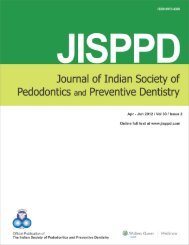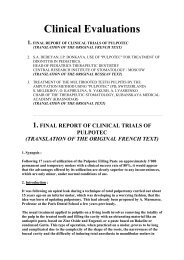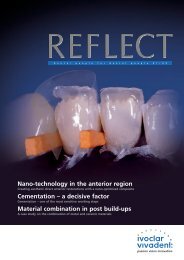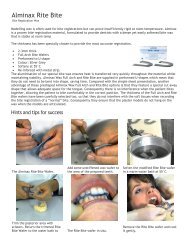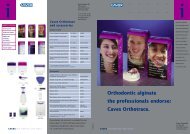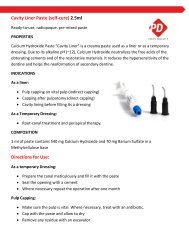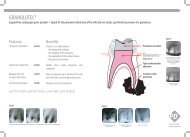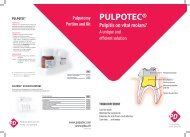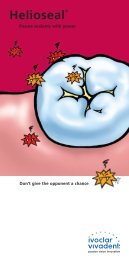to View In Vivo Study - universaldental.com.pk
to View In Vivo Study - universaldental.com.pk
to View In Vivo Study - universaldental.com.pk
- No tags were found...
You also want an ePaper? Increase the reach of your titles
YUMPU automatically turns print PDFs into web optimized ePapers that Google loves.
WJD<br />
A Comparative Evaluation of Noninstrumentation Endodontic Techniques with Conventional ZOE Pulpec<strong>to</strong>my in Deciduous Molars<br />
primary teeth. 1 Maintaining the integrity and health of oral<br />
tissues is the primary objective of pulp treatment.Conservative<br />
treatments are re<strong>com</strong>mended for primary teeth whose pulps have<br />
the potential <strong>to</strong> recover once the irritation is removed.<br />
Various techniques have been described for conserving<br />
primary molars whose pulps have be<strong>com</strong>e nonvital or have<br />
degenerated <strong>to</strong> the extent that they are not good candidates for<br />
vital pulp therapy. Most of these techniques can be assigned <strong>to</strong><br />
one of two major classifications. Representatives of one group<br />
advocate removing the contents of pulp chamber and placing<br />
some sort of medication over the radicular pulp stump for a<br />
varying period of time. Representatives of the second group<br />
advocate removing all accessible pulp tissue, controlling the<br />
organisms and their <strong>to</strong>xins with a rotation of drugs, and res<strong>to</strong>ring<br />
the canals with an absorbable filling material. 18<br />
McDonalds R advocates partial pulpec<strong>to</strong>my technique for<br />
deciduous teeth that have hyperemic pulp without painful<br />
pulpitis. 19 The usual treatment applied <strong>to</strong> pulpitis on a vital<br />
<strong>to</strong>oth is pulpec<strong>to</strong>my. 12 ZOE is the most widely used preparation<br />
for primary <strong>to</strong>oth pulpec<strong>to</strong>mies. 20 Erausqin and Muruzabal used<br />
ZOE as a root canal filling material in 141 rats followed from 1<br />
<strong>to</strong> 90 days. They noted that ZOE irritated the periapical tissues<br />
and caused necrosis of bone and cementum. 21<br />
<strong>In</strong> 1982, Jerrell and Ronk presented a case report of<br />
overfilled ZOE pulpec<strong>to</strong>my in which succedaneous premolar<br />
was malformed. 22 Coll et al in 1985 reported a more than 80%<br />
success rate of one-visit ZOE pulpec<strong>to</strong>my followed a mean time<br />
of 70 months. They found ZOE retained in the tissue after eight<br />
of 17 molars exfoliated. 23<br />
Ana<strong>to</strong>mic situations like the often-<strong>com</strong>plicated shape of root<br />
canals and the closeness of the advancing <strong>to</strong>oth bud make root<br />
canal treatment difficult. 5 Groter (1967) 24 advocated <strong>to</strong> avoid<br />
the use of instruments <strong>com</strong>pletely while Spedding (1973) 25<br />
advocated <strong>to</strong> use instruments in the root canals <strong>to</strong> the point of<br />
resistance. Yacobi et al (1991) 26 were in favor of minimal<br />
biomechanical preparation. Garcia Godoy (1987) 27 preferred<br />
<strong>to</strong> enlarge the root canals only <strong>to</strong> the level of occlusal plane of<br />
the permanent <strong>to</strong>oth germ.<br />
Hobson 1970 28 found that tubules in the dentinal walls of<br />
the root canals, in 70% of the samples of extracted teeth with<br />
necrotic in both radicular and coronal pulp, were penetrated by<br />
microorganisms. He concluded that it would be desirable,<br />
therefore, when treating nonvital infected primary teeth <strong>to</strong> use<br />
an antibacterial drug capable of penetrating the tissues and<br />
controlling infection in the dentinal walls.<br />
Several investiga<strong>to</strong>rs agree that <strong>to</strong>tal removal of the pulp<br />
tissue from the root canals of primary teeth cannot be achieved<br />
because of their <strong>com</strong>plex and variable morphology. It is also<br />
difficult <strong>to</strong> eliminate the wide range of organisms in infected<br />
root canals. Thus, the particular quality of the medicament/paste<br />
determines the prognosis in the endodontic treatment of infected<br />
primary teeth. Identifying the best formulation of ingredients<br />
and techniques <strong>to</strong> predictably produce pulpal healing remains<br />
elusive. It is generally agreed that prognosis after any type of<br />
the pulp therapy improves in the absence of contamination by<br />
pathogenic organisms. Thus, bio<strong>com</strong>patible neutralization of<br />
any existing pulpal contamination and prevention are worthy<br />
goals in vital pulp therapy. If the treatment material in direct<br />
contact with pulp also has some inherent quality that promotes,<br />
stimulates or accelerates a true tissue healing response, so much<br />
better, however, it is recognized that vital pulp tissue can recover<br />
from a variety of insults spontaneously in a favorable<br />
environment. 29<br />
Noninstrumentation endodontic treatment procedures<br />
applied <strong>to</strong> the use of Pulpotec and lesion sterilization and tissue<br />
repair are based on the above concepts.<br />
The overall success rate of ZOE (78.5%) was consistent<br />
with the results of Mortazavi M and Mesbahi M (2004) 39 who<br />
also reported the overall success rate (clinical and radiographic)<br />
of 78.5% for ZOE at the end of 10 <strong>to</strong> 16 months follow-up<br />
period. The results were also in <strong>com</strong>parison with the study done<br />
by Mani, Chawla and Tewari et al (2000) 34 who reported 83.3%<br />
clinical and radiographic success rate in the ZOE group followed<br />
up <strong>to</strong> 6 months.<br />
The overall success of 94% in “Pulpotec” at the end of 12<br />
months was also in agreement with the results of Maramesse A<br />
(1989) 13 who conducted clinical trials of Pulpotec for long-term<br />
and found a success rate of 80% in deciduous teeth. Our results<br />
were also consistent with those of Dodeyan SA, Donkaya IP<br />
(2003) 36 who reported 100% success rate of Pulpotec during 6<br />
months evaluation.<br />
<strong>In</strong> this in vivo study, the overall (clinical and radiographic)<br />
success rates in LSTR at the end of 12 months were not on<br />
agreement with those of Hoshino E (2004) 16 who reported 80%<br />
clinical success of the procedure. Overall three patients were<br />
seen with intraoral swelling at the end of 6 months follow-up<br />
and the main <strong>com</strong>plications encountered were radicular<br />
radiolucency and internal resorption on radiographic followup<br />
at 6 and 12 months intervals. The poor success rate can be<br />
attributed <strong>to</strong> the fact that radiographic criteria were also used<br />
<strong>to</strong> assess the success, which was not done in the earlier studies.<br />
There are limited and conflicting reports in the literature <strong>to</strong><br />
substantiate the clinical and radiographic success rate of LSTR.<br />
From the above study, it was concluded that “Pulpotec”<br />
can be used as a proven, safe and effective alternative <strong>to</strong><br />
conventional ZOE pulpec<strong>to</strong>my in teeth with pulpal exposure<br />
secondary <strong>to</strong> caries with or without partial necrosis, which<br />
eliminates the need <strong>to</strong> instrument in<strong>to</strong> the canals and simplifies<br />
the procedure.<br />
We re<strong>com</strong>mend further long-term clinical and radiographic<br />
evaluations for LSTR before it can be re<strong>com</strong>mended as NIET.<br />
CONCLUSIONS<br />
1. Our study concluded that pulpo<strong>to</strong>my and pulpotec could be<br />
a good alternative for conventional ZOE pulpec<strong>to</strong>my<br />
2. Long-term clinical and radiographic evaluations should be<br />
undertaken <strong>to</strong> further strengthen the efficacy of LSTR as<br />
NIET.<br />
World Journal of Dentistry, July-September 2011;2(3):187-192 191



